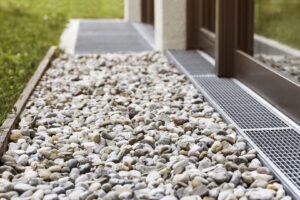
Let’s go over how you can use gravel to help your property’s landscape drainage.
No one wants to find pooling water on their lawn or attempt to protect their plants every time it rains. Excess moisture can wreak havoc on your property and sanity, from soggy lawns to flooded basements. This is why you need effective water drainage around your home. Luckily, gravel is an easy and effective way to drain water around your home’s foundation. Gravel is your best friend when combating excess water on your lawn. Let’s go over how you can use gravel to help your property’s landscape drainage.
The Dangers of Poor Drainage
It starts with a few puddles after a storm. Your yard takes longer than usual to dry out, but you don’t think much of it. But then problems begin to grow. Tiny puddles turn into ponds after every rainstorm. The grass never dries out, leaving your yard a muddy mess. Low spots in the lawn seem to get lower, expanding the wet spots. Landscape beds that once shed water effectively now retain it like a sponge.
Unchecked drainage issues also damage landscaping. Damp soil suffocates plant roots, leading to dead patches and an increased risk of disease. Extended moisture exposure causes erosion as runoff carries away the topsoil. Even mature trees can suffer when their roots are submerged.
How Does Gravel Improve Drainage?
Gravel is a popular choice among landscapers due to its natural drainage ability. By installing a layer of gravel, water is redirected away from your home and toward appropriate drainage systems. This prevents water damage to the foundation, basement, and other areas of your home.
Gravel driveways and walkways shed water to the sides, where it can seep into the earth and prevent potholes, and flooding. Gravel paths are also a colorful, natural-looking alternative to paved surfaces.
Also, gravel trenches catch runoff from downspouts and hardscapes. The spaces between the pebbles store water temporarily before directing it into the soil. Strategic trench placement also prevents erosion and keeps water away from foundations. You can even use gravel beds under raised planters, patios, and sheds to lift these structures up and away from the soil. This allows water to flow freely underneath instead of pooling around the structure.
Questions? Lehnhoff’s Supply is Here to Help
If you still have more questions about gravel use in your outdoor landscaping designs, the trained professionals at Lehnhoff’s Supply are here to help you.
Find us at 2708 Belair Road, Fallston, MD 21047 and give us a call at 410-510-7646. For tips, tricks, and to see what we have been up to, be sure to follow us on Facebook, X – Twitter, and Pinterest!
We serve but aren’t limited to, the following parts of Maryland: Harford County – Fallston, Forest Hill, Joppa, Edgewood, Bel Air, Churchville, Havre de Grace, Jarrettsville, Street, Aberdeen, Abingdon, and Joppatowne. In Baltimore County: Kingsville, Perry Hall, Overlea, Fullerton, Nottingham, Parkville, Towson, Carney, Loch Raven, Lutherville, Timonium, Hunt Valley, Cockeysville, Sparks, Glyndon, Pikesville, Reisterstown, Ruxton, Parkton, Glen Arm, Baldwin, Monkton, Long Green, White Marsh, Rosedale, Phoenix, and Fork.
